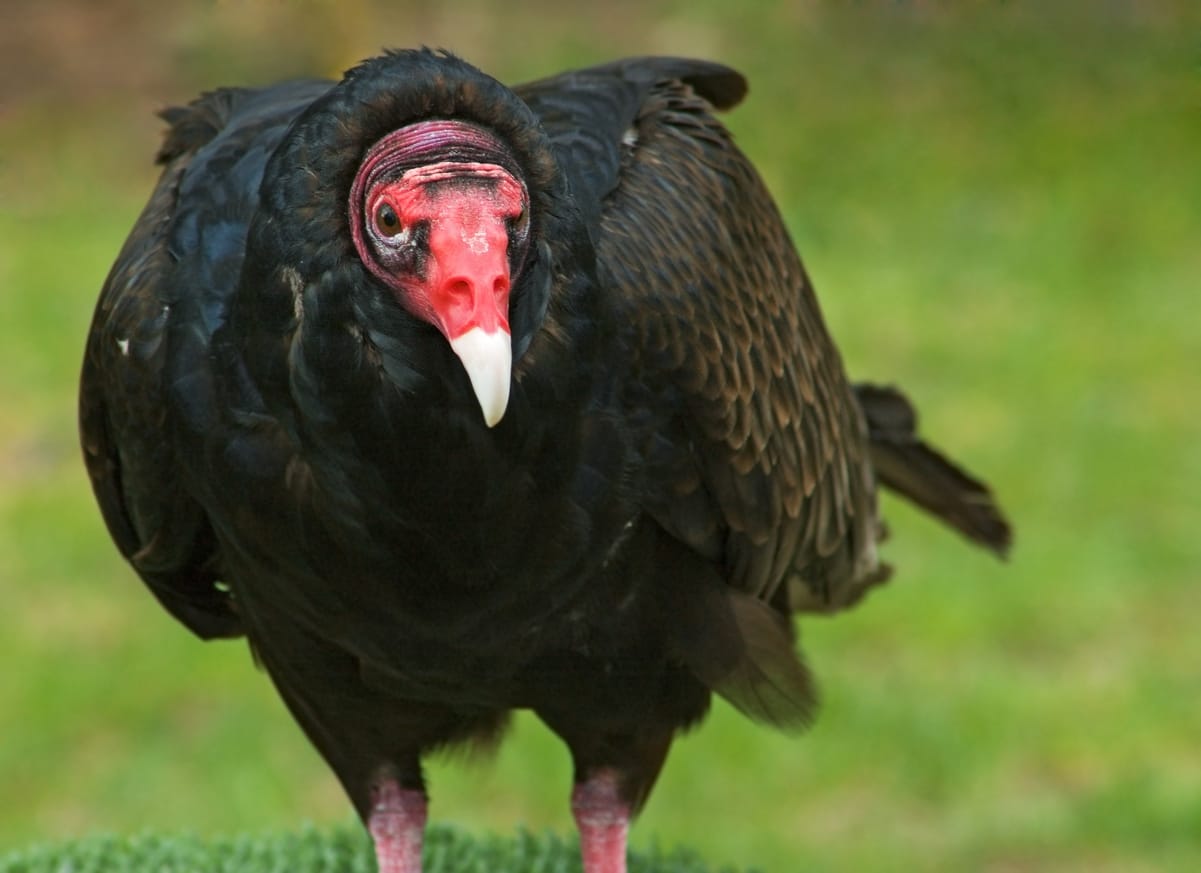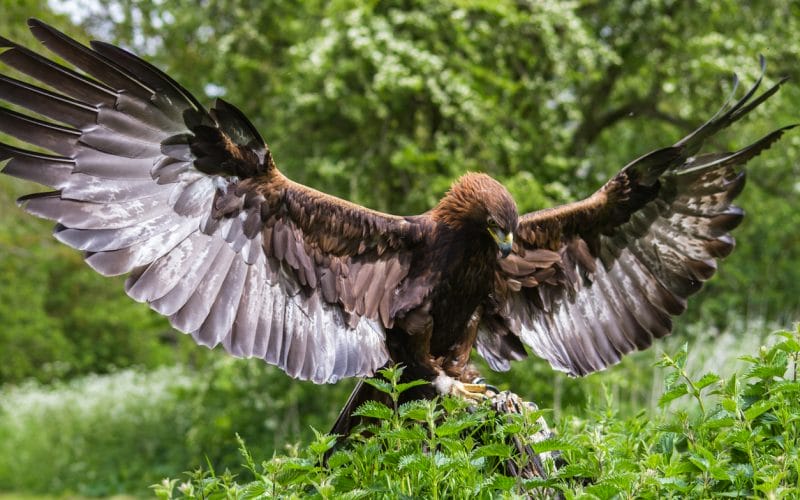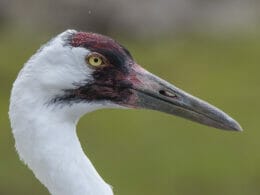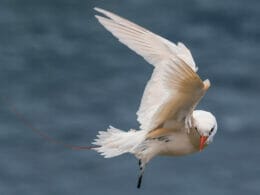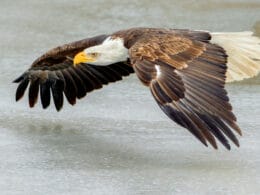Wisconsin is a beautiful state with an enviable location that attracts a lot of birds. Because it’s located on the shore, it draws a variety of fish-eating birds.
Because it’s hot and humid in the summer, Wisconsin will attract birds that don’t mind the heat. It will also draw birds that prefer chilly temperatures, seeing as its winters are freezing cold.
Seeing as Wisconsin is home to a variety of beautiful wildlife birds, this post attempts to cover the most common Wisconsin birds of prey. Let’s jump right into it!
Top 9 Most Common Wisconsin Birds of Prey
1. American Kestrel

American Kestrels can be found in all parts of the western hemisphere. They’re notable for their small size, ranking as the world’s second-smallest falcon.
The American Kestrel is sexually dimorphic. Females have dark red wings, while males have blue wings. Both sexes have powerful claws and bills that can quickly catch and kill animals.
These birds have sharp eyes and are able to see in UV light. It’s a great skill that allows them to keep watch of their targets while flying in mid-air.
Author Note: Kestrels’ diet consists of a variety of prey. They like to feed off insects such as grasshoppers and cicadas. They also like to hunt small animals such as mice and small birds.
The birds prefer wide spaces such as deserts and fields to call home. Forests with many trees and mountains are the only areas they dislike.
2. Cooper’s Hawk

Cooper’s Hawks are North American natives recognized for their super swift movement, which enables them to pursue big and elusive animals.
Cooper’s Hawk is moderate-sized. They have hooked beaks that may easily pierce flesh. The upper parts have a bluish-grey tint, with red on the underside.
Young hawks are dark above with brown streaks on the top breast. These brown streaks create a cloaked appearance.
These birds are stealthy hunters. They sneak into cover to observe their target before launching with a quick and sudden speed to catch it.
Occasionally, they fly close to the ground to catch animals off guard from behind.
When it comes to their diet, Cooper’s Hawks primarily consume birds. They usually eat robins and other medium-sized birds. The Cooper’s Hawks also hunt chipmunks, squirrels, and bats.
The Cooper’s Hawks prefer old forests and open woods to nest. Large trees in the suburbs as well as around rivers are also preferable.
3. Rough-Legged Buzzard
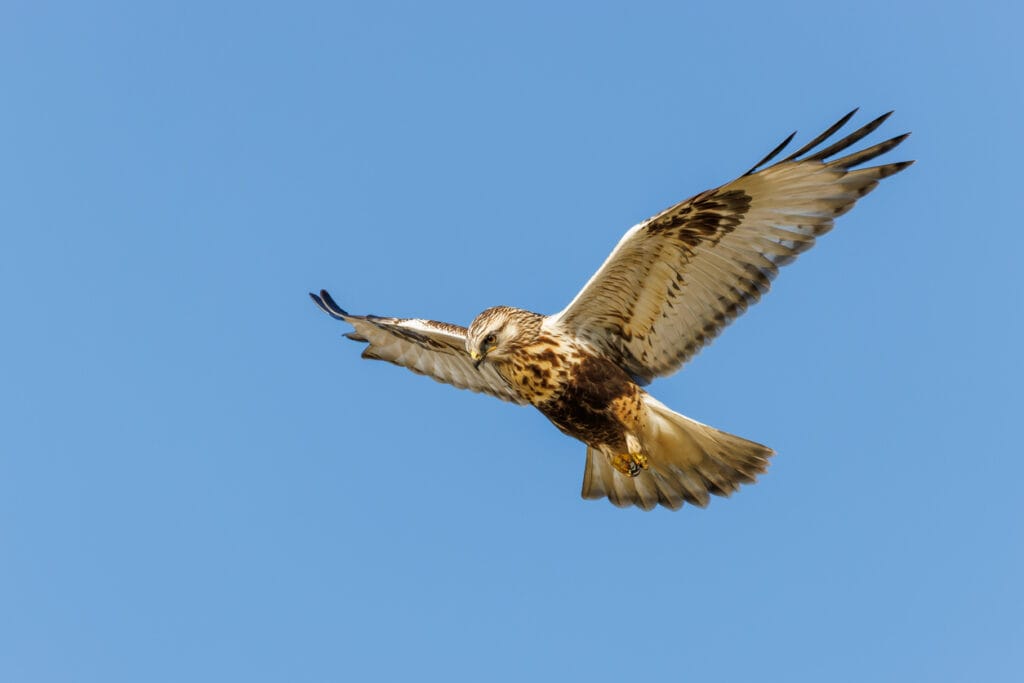
Rough-legged Buzzards are raptors that can be found all throughout the northern hemisphere. They’re also called Rough-legged Hawks.
These birds are arctic breeders who enjoy the cold. During the winter, you’ll probably be able to catch their sight more.
Top Tip: These raptors got their name from the fact that their feet are feathered to the toes.
Rough-legged Buzzards are sexually dimorphic. The females are bigger and bulkier than their male counterparts. They also have a large dark belly patch and a single broad tail terminal band.
Males have a smaller belly patch and narrower tail bands than females. The upper parts of both sexes are black and spotty, while the underparts are light. The upper side of the tail clashes with the black back, as the tail has a white base.
Their wings are elevated in a little V-shape when they fly.
Rough-legged Hawks hunt by flying towards the wind’s direction. They then hover in search of food. They also frequently sit on power lines and tree branches scanning for prey.
They usually eat small mammals, including rabbits, mice, and voles. They can also eat other prey like earthworms.
Rough-legged Buzzards reside in open country and farming lands. These raptors are more abundant in open regions, such as grasslands and savannahs.
These birds build their nests in trees or on a steep ledge with a view of open grassland. They do this so it would be easier to hunt for animals for their young ones.
4. Merlin

Merlins are small types of falcons. These birds are adept hunters and have great agility. Their nimbleness makes it easy for them to catch small birds. To catch their prey, they prefer to use unexpected strikes.
Merlins have a moderate-sized tail, highly spiked wings, and a large chest. Their pigmentation differs, but they are often black and splotchy.
Male Merlins are grey, whereas female and young Merlins are browner in color. The undersides of the wings are dark.
Merlins can fly at speeds of up to 40 miles per hour. This speed permits them to capture animals that are slow to react.
Small birds make up the majority of their diet. Other small animals, such as rabbits and rats, are often consumed by them. Insects could also be a source of food for them.
They typically like to fly over forest areas or grasslands. Merlins can be spotted at coastlines as well. They also spend a lot of time looking for prey while sitting in open regions.
5. Snowy Owl
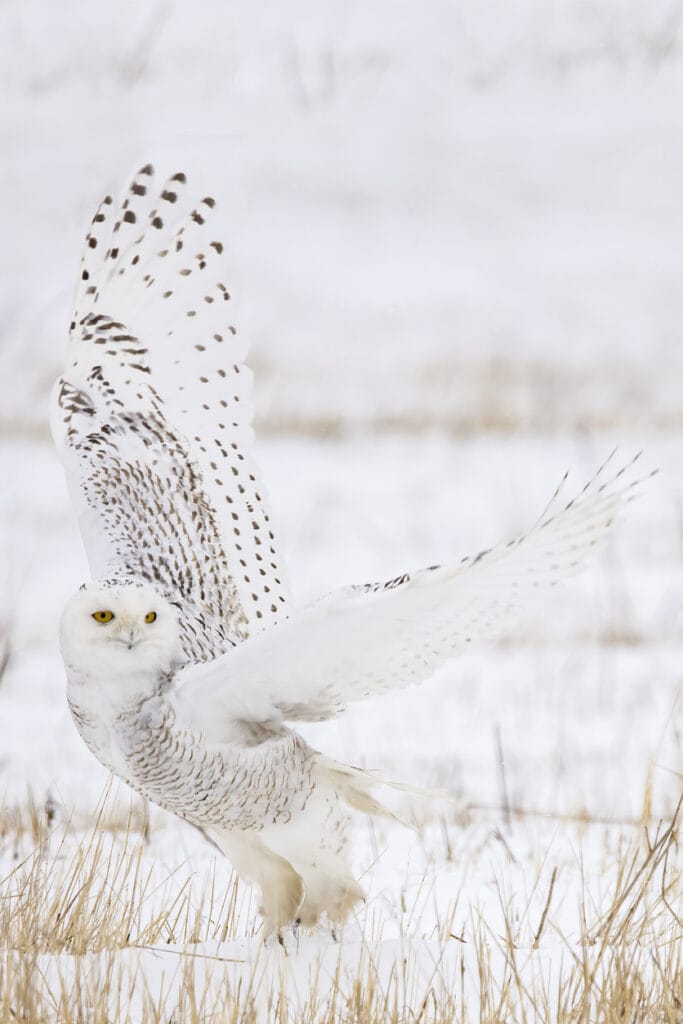
Snowy Owls are large white owls that are common to North America’s Arctic areas. They can also be found in northern Africa, Europe, and Asia north of the Himalayan mountains.
These owls have a lot of feathers, making them one of the bulkier owl species in North America.
Author Note: Snowy Owls have a stunning appearance. They have white bodies and wings with different degrees of black or brown patterns.
The markings on females can be fairly thick. Female tail and flight feathers are brown. Males tend to become lighter in color as they get older.
These owls can often be mistaken for a white stone or a pile of snow when encountered in the wild. It’s an excellent camouflage for avoiding predators.
Snowy Owls like to be alone and are possessive of their territory. During the mating season, males guard their territory. To protect their region, Snowy Owls produce vocal sounds to scare others.
Small rodents are the primary prey of the Snowy Owls, but they will also hunt other animals. To survive, the owls ought to eat many times a day. A group of Snowy Owls can feed on hundreds of rodents per day or more during mating season.
The Snowy Owl enjoys open places with very few trees. To keep an eye on predators, these birds favor elevated locations.
6. Northern Goshawk
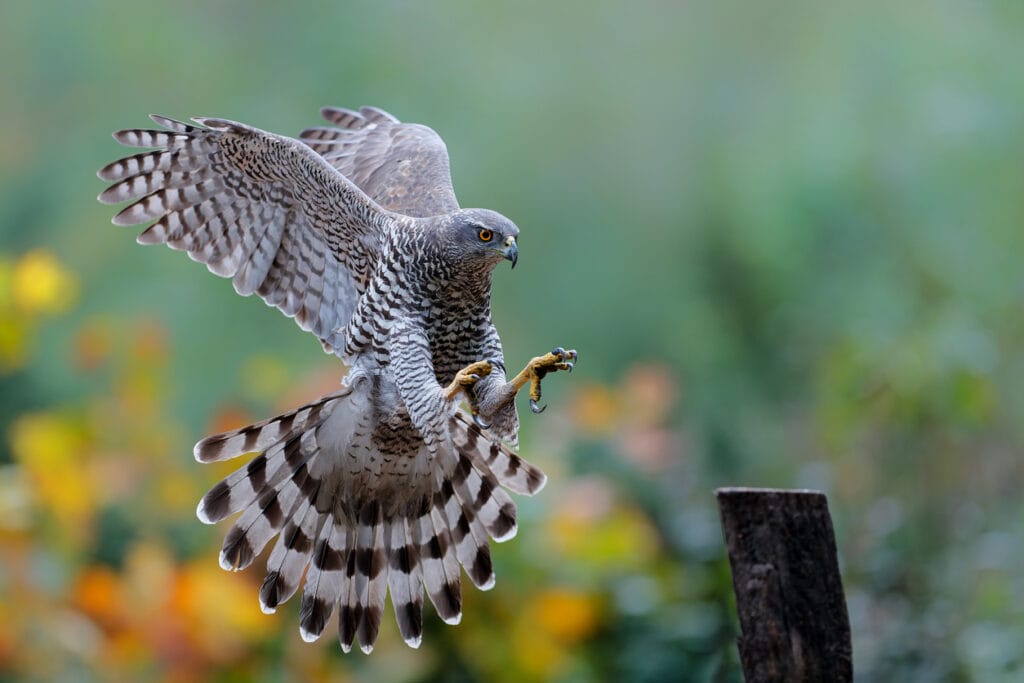
Northern Goshawks are big, sturdy birds. They can launch unexpectedly on their target and attack it on the ground or while chasing it in the sky. They can go at speeds of up to 40 miles per hour.
Northern Goshawks have predators of their own, despite their ferocity. Great Horned Owls and Red-tailed Hawks are among these predators.
Adults have black slate-grey upper parts and are lined with gray undersides. Their eyes are orange and they have a wingspan of 35-50 inches with long secondary flight feathers.
Young birds have brown streaks on their bodies and small black streaks on their tails. Female Goshawks are larger than males, making them sexually dimorphic.
Goshawks are sly hunters who keep an eye out for food from high vantage points. After they find their prey, they attack with a swift movement. Short flights are punctuated with somewhat sluggish wingbeats.
The hawks mostly feed on birds and other small animals. They like to eat crows and squirrels.
In mixed forests, the Northern Goshawks normally nest at a big gap in the tree. They prefer grassland and woods.
7. Broad-Winged Hawk

One of the most popular hawk species in North America is the Broad-winged Hawk. They prefer to stay near the border of woodlands and are inconspicuous.
Adults have a dark red head and a white tail. The light underparts of the wings have a brownish edge. Females are slightly bigger, as is the case with most raptors.
Young hawks have lighter brown underparts with a striping look.
Broad-winged Hawks have a curved look to their wings. Their wings are generally short and wide with a sharp point.
These hawks like to keep an eye out for prey from high points such as tree branches near woodland boundaries. They dive down to grab prey from the ground when they see it.
Top Tip: Except during migration, Broad-winged Hawks are isolated and possessive. They like to travel in flocks called kettles. These flocks can include other raptor species.
The diet of Broad-winged Hawks varies. Small animals, amphibians, reptiles, and birds are among their favorite foods. They can also consume fish and insects.
Broad-winged Hawks prefer to live in the woods. The hawks fly along beaches and mountain slopes during migration. When they fly, they fly frequently in big flocks.
The hawk uses sectors of the forests for breeding. They can be found in thick, undisturbed woodland or mixed woodlands. These raptors are often seen foraging along the highways, trails, or marshland entrances.
8. Black-Crowned Night-Heron

Black-Crowned Night-Herons are widespread in marshes across North America. The majority of their hunting occurs at nighttime. The herons tend to pass time during the day curled among the trees near the shoreline.
The Black-Crowned Night-Heron population is declining due to various dangers. Some of these dangers include water habitat degradation and environmental pollution.
Black-Crowned Night-Herons are a type of heron that’s small in size. Their heads are huge and broad, and their eyes are red. Their bills are thick and pointed, while the wings are curved and wide.
When they fly, their legs seem short and hardly come to the end of the tail. Adults have a black back with white or greys on the rest of their bodies.
Top Tip: The males are significantly larger than the females, although they have equivalent appearances.
Black-Crowned Night-Herons breed in colonies and maintain a social structure throughout the year. Males and females fiercely protect the hunting and breeding areas.
The herons eat primarily fish, but their diet is fairly diverse. They also eat frogs, insects, and carrion, among other things. Some other things that they can consume include the eggs and young birds of other species. This wreaks havoc on other birds’ colonies.
These birds can be found in a range of water settings, including freshwater and saltwater. To evade predators, the birds build their nests in tree trunks or under grass.
9. Short-Eared Owl

The Short-eared Owl is one of the most commonly dispersed owls. They use their excellent flight abilities for catching prey. However, they also use it to fly great distances. Short-eared Owls have been seen to travel over 1200 miles in a single migration season.
Unfortunately, their population numbers have plummeted in the past few years. The decrease is probably more than many other birds of prey.
The moderate-sized Short-eared Owl has wide eyes, a large head, and wide wings. It has a small, powerful, hooked bill that is black. Its tail and wings are banded, and its coloring is mottled to brownish-orange.
This owl’s face is light, with bright eyes that are lined in black. Brown streaks run through the breast, while the chest and belly are light.
These owls are one of the rare owl types that build their nests on the ground. The nest is hidden beneath a thicket of vegetation or other plant ground.
The female constructs the nest by raking and then lining it with plant stalks and feathers. She frequently acquires the feathers by picking them from her chest.
During hunting, The Short-eared Owls attack their target from a vantage point. Sometimes they attack while soaring low to the ground.
Short-eared Owls can be observed in the mid-evening, as well as during sundown and sunrise. They mostly consume small animals as they eat small birds. Young owls often feast on insects.
Grasslands, wetlands, deserts, and tundra are ideal habitats for Short-eared Owls. During the breeding season, they can be seen in open areas with a lot of mice and rats. Tundra, seaside plains, and cropland are the most prevalent sites for nesting.
They could also be seen in shrubby places in the winter.
Summary
There you have it; the nine most common birds of prey in Wisconsin. Merlins, Snowy Owls, and American Kestrels are arguably the most common of the bunch.
All of these birds live in different environments than each other. If you live near a body of water, for example, your chances of seeing a Black-Crowned Night-Heron are high.
Whatever bird you come upon, take the time to appreciate its beauty. We hope you enjoyed our guide on the most common Wisconsin birds of prey.
FAQ
The Ferruginous Hawk is the biggest hawk in the U.S. so wherever it is seen, it wins!
Yes, there are. Audubon reports that the annual eagle count across Wisconsin, Minnesota and Iowa usually conclude there are around 100 Golden Eagles present in the state.
Well the Bald Eagle is actually a fish eagle so it loves waterways, rivers and lakes and Wisconsin has plenty of those so it is a perfect place for them.




